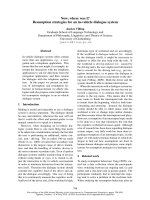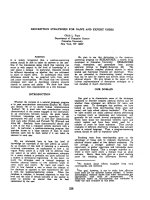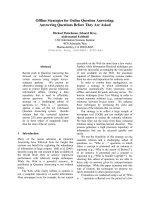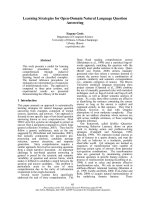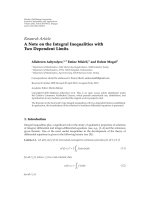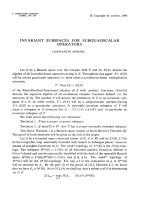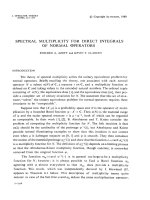Báo cáo toán học: "Potential-Based Strategies for Tic-Tac-Toe on the Integer Lattice with Numerous Directions" potx
Bạn đang xem bản rút gọn của tài liệu. Xem và tải ngay bản đầy đủ của tài liệu tại đây (181.08 KB, 15 trang )
Potential-Based Strategies for Tic-Tac-Toe on the
Integer Lattice with Numerous Directions
Klay Kruczek
Western Oregon University
Eric Sundberg
Occidental College
Submitted: May 29, 2009; Accepted: Dec 18, 2009; Published: Jan 5, 2010
Mathematics Subject Classification: 91A46
Abstract
We consider a tic-tac-toe game played on the d-dimensional integer lattice. The
game that we investigate is a Maker–Breaker version of tic-tac-toe. In a Maker–
Breaker game, the first player, Maker, only tries to occupy a winning line and the
second player, Breaker, only tries to stop Maker from occupying a winning line. We
consider the bounded number of directions gam e, in which we designate a finite set
of direction-vectors S ⊂ Z
d
which determines the set of winning lines. We show, by
using the Erd˝os–Selfridge theorem and a modification of a theorem by Beck about
games played on almost-disjoint hypergraphs, that for the special case when the
co ordinates of each direction-vector are bounded, i.e., when S ⊂ {v : v
∞
k},
Breaker can win this game if the length of each winning line is on the order of
d
2
lg(dk) and d
2
lg(k), respectively. In addition, we show that Maker can bu ild
winning lines of length up to (1+o(1))d lg k if S is the set of all direction-vectors with
co ordinates bounded by k. We also apply these methods to the n-cons ecutive lattice
points game on the N
d
board with (essentially) S = Z
d
, and we show that the phase
transition from a win for Maker to a win for Breaker occurs at n = (d + o(1)) lg N.
1 Introduction
The traditional game of 3 × 3 tic-tac- t oe is a type of positional game. In particular,
3 × 3 tic-tac-toe is an example of what we call a strong positional game. In general, a
positional game is a two-person game with complete information played on a hypergraph
(V, H), where V is an arbitrary set , called the board of the game, and H is a family of
subsets of V, called the winn i ng sets. The two players, Player 1 and Player 2, alternately
occupy previously unoccupied elements of V. In a strong positional game, the first player
to occupy all points of some winning set wins. We say that Player 1 has a winn i ng strategy
if no matter what Player 2 does, Player 1 can follow that strategy to win the game. If
neither player has a winning strategy, we say tha t the game is a draw.
the electronic journal of combinatorics 17 (2010), #R5 1
The traditional game of 3 × 3 tic-tac-to e is an example of a stro ng positional game
where the nine positions a r e the vertices and the eight lines ( 3 vertical, 3 horizontal, and
2 diagonal) are the winning sets. Most people are aware that 3 ×3 tic-tac-toe is a draw
game.
By using a strategy stealing argument (see [1] for a description), it can be shown that
in all strong positional games, either Player 1 has a winning strategy or the game is
a draw. Thus, it is reasonable to consider an alternate positional game in which it is
possible for Player 2 to have a winning-strategy. One such game is the Maker–Breaker
game. A Maker–Breaker positional game is where the first player, Maker, only tries to
occupy winning sets, and the second player, Breaker, only tries to stop Maker from doing
so. Thus, in a Maker–Breaker positional game, Maker wins if she occupies all points
of some winning set and Breaker wins if he prevents Maker from doing so. Therefore,
by definition, someone always wins in a Maker–Breaker positional game (there are no
draws). It is interesting to note that when 3 ×3 tic-tac-toe is played as a Maker–Breaker
positional game, Maker has a winning strategy, as Maker does not need to block Breaker
from obtaining a winning line.
Since we will be considering a semi-infinite g ame, i.e., a game where |V | = ∞, |H| =
∞, yet ∀A ∈ H, |A| < ∞, we should describe what constitutes a win f or Breaker in such
a ga me. If a Maker–Breaker game is played on a semi-infinite hypergraph (V, H), then we
say that Breaker ha s a winning strategy on (V, H) if for all j ∈ Z
+
, Breaker can prevent
Maker from completely occupying a winning set by turn j.
We consider the following Maker–Breaker game on Z
d
. The vertices of the board are
all the points of Z
d
. Each winning line has length m, and the directions of the winning
lines are determined by a set of vectors S, which we call the set of direction vectors. We
require that for each v ∈ S, the greatest common divisor of its coordinates is 1, which
we denote by gcd(v) = 1. Also, for each vector v ∈ S, the vector −v ∈ S, since v and
−v determine t he same set of winning lines. This way we can say that the set of winning
lines is
{{p, p + v, p + 2v, . . . p + (m − 1)v} : p ∈ Z
d
, v ∈ S},
We refer to this game as MB
d
S
(m).
Our paper contains three main results which are found in Sections 2, 3, and 4. In
Section 2, we focus on the bounded-coordinates version of MB
d
S
(m), i.e., where S ⊂ {v :
v
∞
k}, and we describe a strategy that allows Breaker to win if the length m of each
winning line is m = (2 + o(1))d
2
lg (dk) (as k → ∞ and d → ∞), where lg is the binary
logarithm. Similarly, Breaker has an explicit winning strategy if (i) d is fixed, k → ∞,
and m = (2 + o(1))d(d + 1 ) lg(k) or (ii) k is fixed, d → ∞, and m = (2 + o(1))d
2
lg(d).
This strategy is essentially a generalization of a Player 2’s winning strategy given by
Beck [1] (page 157), for the 40-in-a-row game played on Z ×Z. We also modify a theorem
by Beck [1] (Thm. 34.1, pg. 464) which allows us to further improve our result by showing
that Breaker can win if the length of each winning line is (i) m = (1 + o(1))d
2
lg(k)
(k → ∞ and d → ∞), (ii) m = (1 + o(1))d(d + 1) lg k (d is fixed and k → ∞), or (iii)
m = d
2
(lg(k) + 3c
√
lg k + 1 +
1
k
+ o(1)) (k 2 is fixed, d → ∞, and 0 < c <
1
2
is an
arbitrary constant).
the electronic journal of combinatorics 17 (2010), #R5 2
In Section 3 we focus on the full bounded-coordinates version of MB
d
S
(m), i.e., we
require that S consists of all direction-vectors v such that v
∞
k, with the exception
that if v ∈ S, then −v ∈ S. For the full bounded-coordinates game, we are able to show
that Maker can build winning lines of length up to (1 + o(1))d lg k. Thus, for the full
bounded-coordinates version of MB
d
S
(m), by combining our results from Sections 2 and 3
we see that when d is fixed and k → ∞, there is only a factor of (d + 1) that separates
what Maker can a chieve and what Breaker can prevent.
In Section 4 we consider the n-consecutive lattice points game on N
d
, which is a finite
game. The board is the set of points of t he N
d
hypercube, and each winning line is a set
of n consecutive la tt ice points lying on a straig ht line, where we allow any direction-vector
for determining the direction of a winning line. Using similar strategies to those used in
Sections 2 and 3, we show that the phase transition from a win for Maker to a win for
Breaker occurs at n = (d + o(1)) lg N.
2 Potential-Based Breaker’s Strategies for the
Bounded Coordinates Game
Consider the classic 3 ×3 tic-tac-toe game and the N
d
tic-tac-toe games. Each direction-
vector v in those games has the property that the magnitude of each o f its coordinates is
at most 1, i.e., if v = (v
1
, . . . , v
d
) is a direction-vector, then |v
i
| 1 for 1 i d. A logical
generalization of this game is to consider a tic-tac-toe game played on Z
d
where the set
of direction-vecto rs S contains direction-vectors (i.e., vectors v with gcd(v) = 1 ) whose
coordinates satisfy |v
i
| k f or 1 i d. In this section we prove two theorems that give
criteria for Breaker to have an explicit winning strategy in the bounded coordinates game,
i.e., MB
d
S
(m) where S ⊂ {v : v
∞
k}. Both theorems gener alize techniques used by
Beck [1].
The first theorem states that Breaker can block lines whose lengths are on the order of
d
2
lg(kd) (as k, d → ∞ ) in the bounded coordinates game, and relies directly on the Erd˝os–
Selfridge theorem [2]. The Erd˝os–Selfridge theo rem says that fo r a finite hypergra ph H,
if
A∈H
2
−|A|
<
1
2
, then Breaker has an explicit winning stra t egy for the Maker–Breaker
game played on H. During each turn, the Erd˝os–Selfridge strategy assig ns a “potential”
(based on a power-o f-2 scoring function) t o the current position of the board. This
potential measures Maker’s ability to win from that p osition, and the Erd˝os–Selfridge
strategy requires Breaker t o occupy a point that will destroy the most potential.
Our second theorem, which states that Breaker can block lines whose lengths are on the
order of d
2
lg(k) (as k, d → ∞) in the bounded coordinates game, uses a mo r e complicated
approach developed by Beck and it also makes use of a potential-based technique. Both
theorems only apply to finite games, so first we describe how Breaker can win the semi-
infinite game MB
d
S
(m) where S ⊂ {v : v
∞
k} by essentially winning an infinite
number of finite games.
We begin by part itio ning the board Z
d
into sub-boards which are d-dimensional hy-
percubes. Each hypercube has size (mk)
d
, where m, the length of ea ch winning line, will
the electronic journal of combinatorics 17 (2010), #R5 3
be determined later. On each sub-board B, we create a finite game whose set of winning
lines F
B
is defined so that F
B
is
m
d+1
-uniform, and so that if Breaker wins on each
sub-board, then he wins in the whole semi-infinite game. Each A ∈ F
B
will be deter-
mined by a point–directio n-vecto r pair (p,v) as follows: for each point–direction-vector
pair (p, v) ∈ B × S, we let A = {p, p + v, p + 2v, . . . , p +
m
d+1
− 1
v} be an edge in F
B
if
A ⊂ B. Then during each turn, in whichever sub-board Maker occupies a point, Breaker
responds in that same sub-board according to his blocking-strategy for the finite game in
that sub-board. We will show that if m is large enough, then Breaker can win in every
sub-board, and by extension he will win in the entire semi-infinite game MB
d
S
(m).
First notice that a winning line can intersect at most d + 1 different sub-boards. This
is because each “switch” from one sub-board to the next is due to a progression in at least
one of the dimensions. There are only d dimensions, so there can be at most d switches.
If there were d+1 switches, then the line would have two switches in the sa me dimension,
which would imply it covered enough distance in that dimension to completely cross a
sub-board. However, each winning line has m points, and therefore only takes m − 1
“steps” from the first point in the line to the last point. If a line has direction-vector
v = (v
1
, . . . , v
d
), then in the dimension corresponding to the j
th
coordinate, the distance
in that dimension between the first point of the line and the last point of the line is
(m − 1)|v
j
|. However, (m − 1)|v
j
| < mk for 1 j d; thus a winning line cannot have
two switches in the same coordinate.
Since a winning line A can intersect at most d+1 different sub-boards, it must intersect
some sub-board in a t least |A|/ ( d + 1) points. If A intersects sub-board B in at least
m
d+1
points, then A ∩B ⊇ A
′
for some A
′
∈ F
B
, and Breaker will eventually occupy a point of
A
′
, via his blocking-strategy for the finite game played on B. Thus, Breaker will eventually
occupy a point o f A. Therefore, in the proofs of Theorems 1 and 2, we determine the
length m of the winning-lines which allows Breaker to win on each of the individual
sub-boards by using his finite-ga me blo cking-strategy.
Theorem 1 In the bo unded coordinates version of MB
d
S
(m), i. e., when S ⊂ {v : v
∞
k}, if k, d → ∞ or if d → ∞ and k is fixed, then Breaker has an explicit winning strategy
if m = (2 + o(1) )d
2
lg(dk). If d is fixed and k → ∞, Breaker has a n explicit winnin g
strategy if m = (2 + o(1))d(d + 1) lg(k).
Proof: As described above, we partition the boa rd Z
d
into sub-boards of size (mk)
d
. The
Erd˝os–Selfridge theorem says that for a finite hypergraph H, if
A∈H
2
−|A|
<
1
2
, t hen
Breaker has an explicit winning strategy for the Maker–Breaker game played on H. For
an arbitrary sub-board B, consider the game played o n the finite hypergraph (B, F
B
).
Each A ∈ F
B
satisfies |A| =
m
d+1
. We bound |F
B
| from above by (mk)
d
(2k+1)
d
2
, which
is an upper bound on |B × S|. (In this over-count, we have counted vectors v such that
gcd(v) > 1, but we have avoided counting both v and −v.) So if we find a value of m so
that
A∈F
B
2
−|A|
(mk)
d
·
(2k + 1)
d
2
· 2
−m/(d+1)
< 1/2,
the electronic journal of combinatorics 17 (2010), #R5 4
then Breaker will have an explicit winning strategy for the ga me played on the sub-board
B. We see that the right-hand inequality is equivalent to
d(d + 1)[lg(m) + lg(2k
2
+ k)] < m.
which will be satisfied if either
m > (2 + o(1))d
2
lg (kd) as k, d → ∞, or as d → ∞ and k is fixed,
or
m > (2 + o(1))d(d + 1) lg(k) as k → ∞, and d is fixed.
If we use a more sophisticated blo cking-strategy for Breaker, then we can improve our
results from Theorem 1 by a factor of 2 when d is fixed and k → ∞, and we have an even
bigger improvement in the cases where d → ∞ since we eliminate the lg(d) term.
Theorem 2 In the bo unded coordinates version of MB
d
S
(m), i. e., when S ⊂ {v : v
∞
k}, if k → ∞ and d → ∞, then Breaker has a n expli cit winning strategy if m = (1 +
o(1))d
2
lg(k). If d is fixed and k → ∞, Breaker has an explicit winning strategy if m =
(1 + o( 1))d (d + 1) lg(k). If k 2 is fixed and d → ∞, Breaker has an explicit winni ng
strategy if m = d
2
(lg k + 3c
√
lg k + 1+
1
k
+ o(1)), where 0 < c <
1
2
is an arbitrary constant.
Proof: Our proof proceeds exactly like the proof of Theorem 1, except instead of using
the Erd˝os–Selfridge theorem on each sub-board of size (mk)
d
, we use a modified form of
Theorem 3 4.1 from Beck [1] on these sub-boards.
Theorem 3 (Beck [1]) Let F be an n-uniform Alm ost Disjoi nt hypergraph. Assume
that the Maximum Degree of F is at mo st D, that is, every poi nt of the board is contained
in at most D hyperedges of F. Moreover, assume that the total number of winning sets is
|F| = M. If there is an integer ℓ with 2 ℓ n/2, such that
M
n(D − 1)
ℓ
< 2
nℓ−ℓ(ℓ+1)−
(
ℓ
2
)
−1
, (1)
then Breaker has an explicit w i nni ng strategy for the game played on F.
Notice that Theorem 3 is about almost disjoint hypergraphs, where a hypergraph F is
called almost disjoint if |A ∩ B| 1 f or all distinct A, B ∈ F. Each hypergraph from
a sub-game of MB
d
S
(m) played on an (mk)
d
sub-board is close to being almost disjoint.
However, two intersecting hyperedges with the same direction-vector will often intersect
in more than one point. To handle this complication, we modify the proof of Theorem 3
and determine that Breaker can win on such a game if
M
n(D − 1)
ℓ
< 2
nℓ−ℓ(ℓ+3)−
(
ℓ
2
)
−1
. (2)
the electronic journal of combinatorics 17 (2010), #R5 5
Since the proof of Theorem 3 is rather difficult, we will describe how to appropriately
modify the proof in order to obtain o ur result. In the following discussion, the reader
should think of F as the set of winning sets F
B
of a particular sub-game on a particula r
sub-board B where n =
m
d+1
.
Theorem 3 follows a BigGame–SmallGame decomposition where, in Breaker’s mind,
during each turn, the game is partitioned into two games, so that the BigGame shrinks
and the SmallGame grows as the whole game progresses. Initially, the vertex set of the
BigGame is all o f V (F) and the vertex set of the SmallGame is empty. We let V
BIG
(j)
and V
small
(j) denote the set of vertices of the BigGame and SmallGame, respectively,
for the time occurring immediately after Maker’s jth move up until her (j + 1)th move.
We let V
BIG
and V
small
(with no index) be the vertices in the BigGame and Sma llGame,
respectively, at the end of the game. Breaker follows the self-imposed rule that whenever
Maker occupies a point from the BigGame, Breaker responds in the BigGa me; however,
whenever Ma ker occupies a point fro m the SmallGame, Breaker allows himself to respond
in either the BigGame or the SmallGame. We let X(j) and Y (j) be the sets of points
that Maker has occupied and Breaker has occupied, respectively, by the end of turn j . We
let X
BIG
(j), X
small
(j), Y
BIG
(j), Y
small
(j) denote the sets of points tha t Maker has occupied
from the BigGa me, Maker has occupied from the SmallGame, Breaker has occupied from
the BigGame, and Breaker has occupied from the SmallGame, respectively, by the end
of turn j. (We use the phrasing, “by the end of turn j,” to emphasize that the sets
of Maker’s points are updated immediately after her move during turn j, which occurs
halfway throug h turn j.) Breaker essentially uses the BigGa me as a device for positioning
himself to win the SmallGame. The SmallGame is essentially where Breaker focuses on
blocking any surviving sets which Maker is close to completely occupying.
A set A ∈ F becomes d ang erous during turn j if the following three criteria occur:
1. A is a survivor set at the end of turn j − 1, i.e., A ∩Y (j −1) = ∅.
2. By the end of turn j, Maker occupies all except for ℓ+3 points of A in the BigGame,
i.e., |A \X
BIG
(j)| = ℓ + 3.
3. At the end of turn j − 1, Maker did not occupy all except for ℓ + 3 points of A in
the BigGame, i.e., |A \X
BIG
(j −1)| > ℓ + 3.
If a set A ∈ F becomes dangerous during turn j, then immediately after Maker’s move
during turn j (i.e., before Breaker’s move during turn j), the set E = A \ X
BIG
(j) is
classified as an emergency set (in the SmallGame), the set A is labeled a dang erous
ancestor of E, and the vertices of E are moved to the SmallBoard, i.e., V
small
(j) :=
V
small
(j −1) ∪E and V
BIG
(j) := V
BIG
(j −1) \E. We stress that this is the only way that
points move to the SmallBoard (and points never move back to the BigBoard). Thus,
every point p ∈ V
small
is brought into the SmallBoard by some emergency set E, which we
call a small - parent o f p. And just as every point p ∈ V
small
has at least one small-parent,
we note that every emergency set E has at least one dangerous ancestor. Now that we
have described how points are moved to the SmallBoard, we describe small sets in general.
the electronic journal of combinatorics 17 (2010), #R5 6
Let A ∈ F. Suppose there exists a j ∈ Z
+
such that A ∩ Y (j − 1) = ∅ and |A ∩
V
small
(j)| ℓ + 3. Let i be the minimum such j. Then the set S = A ∩ V
small
(i) is
classified as a small set immediately after Maker’s move during turn i and remains a
small set for the duration of the game, and we call A an ancestor of S. We note that
a small set may have many ancestors, but we will stipulate that there are not repeated
edges in the SmallGame. Now we describe the BigGame and what constitutes a win for
Maker in each of the two games.
An ℓ-element subfamily G = {A
1
, . . . , A
ℓ
} ⊆ F is called almo st-disj ointly-link ed if
|A
i
∩A
j
| 1 for 1 i < j ℓ and there exists a set A ∈ F \G such that |A ∩A
i
| = 1 for
1 i ℓ. A big s et B =
A∈G
A is a set where G is an almost-disjointly- linked ℓ-element
subfamily of F. Maker wins the BigGame if at some turn j, there is some big set B such
that B ∩ X
BIG
(j) conta ins all but ℓ(ℓ + 3) points of B and B ∩ Y
BIG
(j − 1) = ∅. Maker
wins the SmallGame if at some turn j, there is a small set S such t hat S ⊆ X
small
(j).
We will show that if Breaker wins the BigGame, then he can follow a simple strategy to
win the SmallGame. Moreover, if Breaker wins the SmallGame, then he wins the overall
game.
In order to describe how winning the BigGame allows Breaker to win the SmallGame,
we need to make some more observations and definitions. For a set A ∈ F with direction-
vector v, we call D(A) = v the direction-vector of A. Likewise, for a small set S with
direction-vector v, we call D(S) = v the direction-vector of S. We note that for a point p ∈
V
small
, every small-parent of p has the same direction-vector. Indeed, let E
1
and E
2
both
be small-parents of p, and consider the turn j when p joins the SmallBoard. Let x
j
∈ V
BIG
be the point occupied by Maker during turn j. Since E
1
and E
2
are small-parents of p,
not only do they both contain p, but they both became emergency sets during turn j; thus
their respective dangerous ancesto rs A
1
and A
2
both co ntain the po ints x
j
and p. Since
A
1
and A
2
share at least two points, we must have D( A
1
) = D(A
2
). But since E
i
⊆ A
i
and |E
i
| = ℓ + 3 for i ∈ {1, 2}, we also have that each emergency set shares more than
two points with its dangerous ancestor and ther efor e D (E
1
) = D(A
1
) = D(A
2
) = D(E
2
).
Since every small-parent of p ∈ V
small
has the same direction-vector, we define the
direction-vector of p to be the direction-vector of any o f the small-parents of p, i.e., if
p ∈ V
small
and E is a small-parent of p with D(E) = v, then D(p) = v also. For each
small set S, we call p ∈ S a same-direction-vector point for S if D(p) = D(S). We let
C
S
= {p ∈ S : D(p) = D(S)} be the set of same-direction-vector points of S a nd we
let N
S
= { p ∈ S : D(p) = D(S)} be the points of S whose directio n-vecto r is different
from that of S, i.e., N
S
= S \ C
S
. We now give an important lemma which states that if
Breaker wins the BigGame, then |N
S
| is not too large. The proof hinges on the idea that
if Breaker wins the BigGame, then there cannot be ℓ dangerous sets that are “linked” by
a single set.
Lemma 1 If Breaker wins the BigGame, then each small set S contains at most ℓ − 1
points whose direction-vector does not match that of S, i.e., for each small set S, |N
S
|
ℓ − 1.
Proof of Lemma 1: Assume towards a contradiction that |N
S
| ℓ, and let p
1
, . . . , p
ℓ
∈
the electronic journal of combinatorics 17 (2010), #R5 7
N
S
. Let E
i
be a small-parent of p
i
and A
i
a dangerous ancestor of E
i
for 1 i ℓ. Let
A be an ancestor of S. Since E
i
is a small-parent of p
i
and p
i
∈ N
S
, we know that
D(A
i
) = D(E
i
) = D(S) = D(A).
Since D(A
i
) = D(A), then |A
i
∩ A| 1 for 1 i ℓ. Moreover, since p
i
∈ A
i
∩ A,
we have |A
i
∩ A| = 1 for 1 i ℓ. It should also be rather obvious that for i = j,
|A
i
∩ A
j
| 1. For suppose |A
i
∩ A
j
| 2 with i = j. Since each A
′
∈ F is a subset of a
line segment in R
d
, then we must have that A
i
, A
j
, and A
i
∪A
j
are all subsets of the same
line segment. Since A and A
i
∪ A
j
both contain the two points p
i
and p
j
, this implies
that D(A) = D(A
i
∪ A
j
), which is a contradiction since D(A
i
∪ A
j
) = D(A
i
) = D(A
j
).
Therefore, |A
i
∩A
j
| 1 for i = j.
So we have established that G = {A
1
, . . . , A
ℓ
} is a family of sets that is almost-
disjointly-linked by A. Thus, B =
ℓ
i=1
A
i
is a big set. Since E
i
⊆ A
i
is an emergency set
for 1 i ℓ, we know that |A
i
\ X
BIG
| = ℓ + 3 for 1 i ℓ. The set B \X
BIG
contains
those points of B that are not occupied by Ma ker, and
|B \X
BIG
|
ℓ
i=1
|A
i
\ X
BIG
| = ℓ(ℓ + 3),
i.e., Maker occupied all except for at most ℓ(ℓ + 3) points of B and therefore won the
BigGame, which is a contradiction to the fact that Breaker wins the BigGame. Therefore
by contradiction, it must be the case that each small set S contains at most ℓ −1 points
whose direction-vector does not match that of S.
Since each small set S satisfies the property that |S| ℓ + 3, an obvious corollary of
Lemma 1 is the following:
Corollary 1 If Breaker wins the BigGame, then each small set S contains at least four
same-direction-vector points, i.e., for each small set S, |C
S
| 4.
To help describe Breaker’s strategy for stopping Maker from fully occupying a small set,
we impose an ordering on the points of each geometric line with direction-vector v ∈ S
that passes through the game board as follows. Fix a geometric line with direction- vect or
v = (v
1
, . . . , v
d
) ∈ S that passes through the game board. Let v
i
be the first non-zero
coordinate of v. If p and q are points on this line, then we say that p < q if the i
th
coordinate of p is less than the i
th
coordinate of q. Moreover, if p < q according t o this
ordering, we say that p is to the left of q, and q is to the right of p. In a similar vein,
if p and q are vertices of the game board such that p < q, then we define the interval
[p, q] to be the intersection of the geometric line segment connecting p and q and the
vertices of the game boa r d. Naturally, (p, q] = [p, q] \ {p} , and [p, q) = [p, q] \ {q}, and
(p, q) = [p, q] \ {p, q}.
We now describe Breaker’s strategy, which we call the Nearest-Neighbor-Strategy, for
stopping Maker from winning in the SmallGame. Suppose that Maker occupies a point
p from the SmallBoard. Consider the geometric line with direction-vector D(p) that
contains p and consider the largest Breaker-fr ee interval I (as defined above) t hat contains
the electronic journal of combinatorics 17 (2010), #R5 8
p and is a subset of that line. Breaker responds by taking an unoccupied point q ∈ I
(from the board) whose distance to p is minimum, i.e., the closest unoccupied po int in I.
(In the case of two points with minimum distance from p, Breaker will take the point to
the left of p. If there are no unoccupied points in I, then Brea ker takes a random point.)
We should again empha size that q may be in either the BigBoard or the SmallBoard. If q
is in the SmallBoar d, the idea is to block small sets that contain both p and q, whereas if
q is in the BigBoard, the idea is to block the ancestors of the small sets that contain bot h
p and q, thus preventing such small sets from ever existing. We say that Breaker stops a
small set S if he either directly occupies a vertex of S or he prevents S from existing by
occupying a point contained in every ancestor of S. We claim that if Breaker wins the
BigGame and follows this strategy, then he prevents Maker from fully occupying a small
set.
Lemma 2 If Breaker wins the BigGame and he uses the Nearest-Neighbor-Strategy de-
scribed abov e, then he also wins the SmallGame.
Proof of Lemma 2: Suppose that Breaker follows a strategy that allows him to win the
BigGame and that he follows the Nearest-Neighbor-Strategy described above. Assume
towards a contradiction that Maker fully occupies a small set S. By Corollary 1, ever y
small set contains at least four same-direction-vector point s. Suppose that the same-
direction-vector points of S are labeled p
1
, p
2
, . . . , p
s
(where s 4) and appear from left
to right in that order. Let us consider the first “interior” same-direction-vector point in
S that Maker occupies, i.e., the first p
i
that Maker occupies where 2 i s −1. We may
assume that when Maker occupies her first interior same-direction-vector point, Breaker
has not yet occupied any points that would have already stopped S (i.e., blocked S or
prevented it from ever existing).
Case 1: When Maker occupies p
i
, both p
i−1
and p
i+1
are unoccupied.
For this case, the unoccupied point closest to p
i
is certainly contained in [p
i−1
, p
i+1
],
and therefore Breaker will respond with a point in the interval [p
i−1
, p
i+1
] and will stop S
at the end of this turn.
Case 2: When Maker occupies p
i
, one of p
i−1
or p
i+1
is already occupied by Maker.
Notice that for this case to hold, since p
i
is the first interior point that Maker occupies,
either i = 2 or i = s − 1. Without a loss of generality, we may assume that i = 2 and
Maker already occupies p
1
. Let q be the point Breaker occupied in response to p
1
. If
q ∈ (p
1
, p
2
), then q ∈ S (or q is in every ancestor of S) and Breaker has stopped S. Thus,
we may assume that q is to the left of p
1
and q ∈ S (or q does not stop S). However,
based on how Breaker chose q, it is the closest unoccupied point to the left of p
1
, and
therefore when Maker occupies p
2
, there are no unoccupied points in the interval [q, p
1
].
Thus, when Breaker goes to choose his response to p
2
, he is forced to pick a point in the
interval (p
1
, p
3
] because he must pick an unoccupied point from a Breaker-free interval
that contains p
2
. Since p
2
is the first interior same-direction-vector point that Maker
occupied (and we assumed that Breaker has not occupied any points that would stop
S yet) we know that p
3
is unoccupied (beca use s 4 implies p
3
is interior); therefore
Breaker will have a point in S (or every ancestor of S) at the end of this turn.
the electronic journal of combinatorics 17 (2010), #R5 9
In both Case 1 a nd Case 2 we reach a contradiction; therefore it must be the case that
Maker cannot fully occupy a small set.
It should be clear that if Maker were to fully occupy all of the vertices of a set A ∈ F,
then she would have to occupy all of the vertices of a small set S ⊆ A. This gives the
following obvious corollary of Lemma 2:
Corollary 2 If Breaker can win the BigGame, then he can block every winning set A ∈ F
in either the BigGame or in the SmallGame.
Thus, we are left to show that Breaker has a winning strategy in the BigGame. We do so
via a lemma that is similar to the Erd˝os–Selfridge theorem.
Lemma 3 (Under the assumption that inequality (2) holds) Breaker has a winning strat-
egy in th e BigGa me.
Proof: We use the following version of a potential-based lemma used in Beck’s proof of
Theorem 3 . This lemma can be found as Lemma 1 in Section 35 of [1].
Beck’s Lemma: Breaker has a winning strategy in the BigGame if the number of
big sets is less than 2
b−1
, where b is a lower bound on the numb er of points Maker
must occupy from a big set B before Breaker o ccupies his first point in B.
Let us find a value for b as well as an upper bound on the number of big sets.
Recall that Breaker wins the BigGame if for each big set B, he can occupy a point
from B before Maker occupies all but ℓ(ℓ + 3) points of B. Let us find a lower bound on
the size of each big set B. Let B =
ℓ
i=1
A
i
be a big set, where G = {A
1
, . . . , A
ℓ
} is an
almost-disjointly-linked ℓ-element subfamily of F and each A
i
∈ F. Then we have
|B| =
ℓ
i=1
A
i
ℓ
i=1
|A
i
| −
1i<jℓ
|A
i
∩ A
j
| nℓ −
ℓ
2
,
since |A
i
∩ A
j
| 1 for each pair of elements in the almost-disjointly-linked ℓ-element
subfamily. Since |B| nℓ −
ℓ
2
for each big set B, we know that in order for Maker to
win t he BigGame, she must occupy at least nℓ−
ℓ
2
−ℓ(ℓ+3) points of some big set B before
Breaker occupies his first point in B. Thus, in our case, we have b = nℓ −
ℓ
2
− ℓ( ℓ + 3).
Now let us get an upper bound on the number of big sets in the BigGame. We can do
this by first selecting a set A ∈ F, then choosing an ℓ- element family almost-disjointly-
linked by A. There are M = |F| choices for A. Since each point of F is in at most D
hyperedges, each point of A will be in at most D − 1 other hyperedges. Thus, there are
at most n(D − 1) hyperedges which intersect A, giving at most
n(D−1)
ℓ
choices for an
ℓ-element family almost-disjointly-linked by A. Therefore we have the following inequality:
# of Big Sets M
n(D − 1)
ℓ
. (3)
the electronic journal of combinatorics 17 (2010), #R5 10
So using our bound from inequality (3 ) and our initial a ssumption in inequa lity (2), we
have
# of Big Sets M
n(D − 1)
ℓ
< 2
nℓ−ℓ(ℓ+3)−
(
ℓ
2
)
−1
= 2
b−1
,
so the hypothesis of Beck’s Lemma is satisfied and Breaker has a winning-strategy for t he
BigGame.
Let us now show what values of m allow inequality (2) to hold, depending on whether
k → ∞ and/or d → ∞.
As stated in the proof of Theorem 1, an upper bound on |B ×S| is (mk)
d
(2k+1)
d
2
, which
in turn is an upper bound on M = |F
B
|.
Since F
B
is
m
d+1
-uniform, we have n =
m
d+1
. We also note that the maximum-degree D
satisfies D n|S|
m
d+1
(2k+1)
d
2
, since for each point and each slope, the number of lines of
length n going through that point with that slope is at most n. Therefore we can bound
the binomial coefficient in inequality (2) as follows:
n(D − 1)
ℓ
m
d+1
2
(2k+1)
d
2
e
ℓ
ℓ
m
2
(2k + 1)
d
e
2d
2
ℓ
ℓ
.
Thus, it is enough to show that
(mk)
d
(2k + 1)
d
2
m
2
(2k + 1)
d
e
2d
2
ℓ
ℓ
< 2
(mℓ)/(d+1)−ℓ(ℓ+3)−
(
ℓ
2
)
−1
, (4)
for some integer ℓ with 2 ℓ
m
2(d+1)
in order to ensure that Breaker will win on F
B
. By
applying the binary logarithm to both sides of inequality (4) and simplifying, we get
d
lg m + 1 + 2 lg(k) + lg
1 +
1
2k
+ ℓ
2 lg m + d + d lg k + d lg
1 +
1
2k
− 1 + lg e − 2 lg d − lg ℓ
<
ℓ
d + 1
m −
3
2
ℓ
2
−
5
2
ℓ, (5)
Using the fact that lg(1 +
1
2k
) <
1
k
and further simplification of (5) yields,
(d + 1)
d lg k + d +
d
k
+
d lg m
ℓ
+
2d lg k
ℓ
+
d
ℓ
+
d
kℓ
+ 2 lg m − lg ℓ − 2 lg d
+
3
2
ℓ + lg e +
3
2
< m. (6)
If we let ℓ = ⌊c
√
m⌋ (where 0 < c <
1
2
is constant), then inequality (6 ) is satisfied when
m > d
2
lg k(1 + o(1)) as d, k → ∞,
the electronic journal of combinatorics 17 (2010), #R5 11
or
m > (d + 1)d lg k(1 + o(1)) as k → ∞, and d is fixed,
or
m > d
2
(lg k + 3c
lg k + 1 +
1
k
+ o(1)) as d → ∞, and k 2 is fixed.
3 Maker’s Strategy for the Full Bounded Coordi-
nates Game
The game we consider in this section is Maker –Breaker tic-tac-toe on Z
d
with direction-
vector set S = {v : v
∞
k}. (The · notation will mean start with the set {v :
v
∞
k}, then throw out any vect ors v with gcd(v) > 1, then from what is lef t throw
out one of −v or v.) Thus, we are considering MB
d
S
(m) with S as defined above, i.e., the
full bounded coordinates game.
Theorem 4 In the full bounded coordi nates version of MB
d
S
(m), i.e., when S = {v :
v
∞
k}, if k → ∞, then Maker has a winning strategy if m = (1 + o( 1))d lg(k). If k
is fixed and d → ∞, Make r ha s a winnin g strategy if m = (1 + o(1))d lg(
2
3
k).
Proof: We use Theorem 1.2 from Beck [1], which states that Maker has a winning strategy
for the Maker–Breaker game played on an m-uniform, finite hypergraph (V, H) if
|H| > 2
m−3
· ∆
2
(H) ·|V |, (7)
where ∆
2
(H) is the max-pair degree. The max-pair degree is defined as follows:
assume that, fixing any two distinct points of the board V , there a re at most
∆
2
(H) winning sets A ∈ H containing both points, and equality occurs for
some point pair, then we call ∆
2
(H) the max-pair degree.
However, in order to use this theorem, we must restrict Maker’s moves (and strategy) to
a finite hypergraph F which is defined so that a win in F constitutes a win in the original
semi-infinte game. Since Maker doesn’t have to block any of Breaker’s lines, whenever
Breaker occupies a point outside of F, Ma ker just takes a random point in F.
Let us define our hypergraph (V, F). The set of vertices is a (3mk )
d
hypercube in Z
d
,
where m (to be determined later) is the length of a winning line in F. A winning line
in F is determined by taking a point p in the (mk)
d
hypercube that is centered in the
middle of V , and appending m −1 points in the direction of one of the direction-vectors
v ∈ S to get a winning line {p, p + v, . . . , p + (m −1)v}.
Now t hat we have defined (V, F), let us find an upper bound on m which, if satisfied,
will imply that inequality (7) is also satisfied and thus Maker has a winning strategy on
F. We will start by finding a lower bound on |F|. As described above, |F| = | S|(mk)
d
.
the electronic journal of combinatorics 17 (2010), #R5 12
Since |S| =
1
2
|{v ∈ Z
d
: v k, and gcd(v) = 1}|, we can get a lower bo und on |S| by
first counting the number of vectors v = (v
1
, v
2
, . . . , v
d
) ∈ Z
d
with |v
i
| k satisfying all of
the following: (i) v
1
, v
2
> 0, (ii) v
2
v
1
, and (iii) gcd(v
1
, v
2
) = 1. Since this only accounts
for when v
1
and v
2
have the same sign, we can double this quantity to account for when v
1
and v
2
have opposite signs. Thus, |S| 2 ·Φ(k) ·(2k + 1)
d−2
, where Φ(k) = Σ
k
i=1
φ(i) and
φ is Euler’s phi-function. By modifying the proo f of Theor em 330 (regarding the average
order of φ(k)) in [3], it can be shown that |Φ(k) −
3
π
2
k
2
| 2k ln(k) + 2k, which easily
yields Φ(k)
1
5
k
2
for all k ∈ Z
+
. So we may conclude that
|F|
1
10
(2k)
d
· ( mk)
d
.
Notice that ∆
2
(F) = m −1 because two lines can intersect in at least two points only if
they are collinear. Therefore, it will be enough for us to find a value of m that satisfies
the fo llowing inequality
1
10
(2k)
d
· ( mk)
d
> 2
m−3
m(3mk)
d
. (8)
By manipulating inequality (8) we get
m < d lg k + d lg
2
3
− lg m + 3 + lg
1
10
. (9)
Inequality (9) is satisfied when
m < (1 + o(1))d lg k as k → ∞
or
m < (1 + o(1))d lg
2
3
k
as d → ∞, and k is fixed.
4 The Maker–Breaker n-Consecutive Lattice Points
Game on N
d
.
In Chapter 14 of Beck [1], he introduces the n-consecutive lattice points game played on
the N × N board {(a, b) ∈ Z
2
: 0 a, b N − 1}. In the Maker–Breaker version of this
game, Maker’s goal is to occupy n consecutive lattice points on any straight line, where
every rational slope is allowed. Beck is able to show in Theorem 14.1 of [1] that the phase
transition from a win for Maker to a win for Breaker happens at n = (2 + o(1)) lg N. In
order to do this, he uses Theorem 1.2 and a modification of Theorem 34.1 of [1]. Using a
similar approach, we will prove the following theorem with respect to the n-consecutive
lattice points game played on the d-dimensional analog of the N ×N board:
the electronic journal of combinatorics 17 (2010), #R5 13
Theorem 5 In the Maker–Breaker game on the N
d
board where Maker’s goal is to occupy
n consec utive lattice points on a line (“n-consecutive”), the phase transition from a win
for Maker to a win for Breaker happens at n = (d + o(1)) lg N.
Proof: Our proof proceeds like the proofs of Theorems 2 and 4, except this time we are
not tiling Z
d
with hypercubes, rather we are considering a single d- dimensional hypercube
B = {(a
1
, a
2
, . . . , a
d
) ∈ Z
d
: 0 a
i
N −1 for 1 i d} and the set of direction-vectors
S = {v ∈ Z
d
: gcd(v) = 1 and v
∞
N
n−1
}. Each A ∈ F will be of the form
{p, p +v, p + 2v, . . . , p+ (n −1)v} where (p,v) is a point–direction-vector pair (p, v). Note
that we sp ecify v
∞
N
n−1
, because otherwise if there is a component v
i
of v, such that
|v
i
| >
N
n−1
, then for each p ∈ B, the po int p + (n − 1)v will not be in B. To help draw a
parallel to our other proofs, we will let k =
N
n−1
.
We first show that Breaker has a winning strategy for the n-consecutive points game
when n = (d + o(1)) lg N. In Theorem 2, the hypergraph F was
m
d+1
-uniform and the
size of the board was (mk)
d
, but for this game, we have that F is n-uniform a nd the size
of the board is N
d
. Therefore, inequality (4) in the proof of Theorem 2 becomes
N
d
(2k + 1)
d
2
n
2
(2k + 1)
d
e
2ℓ
ℓ
< 2
nℓ−ℓ(ℓ+3)−
(
ℓ
2
)
−1
, (10)
where 2 ℓ
n
2
. By applying the binary logarithm to both sides of inequality (10) and
simplifying, we get that Breaker wins the n-consecutive points game when
d
ℓ
lg N + lg( 2k + 1)
+ 2 lg n + d lg(2k + 1) −lg ℓ +
3
2
ℓ + lg e +
3
2
< n. (11)
If we let ℓ = ⌊c
√
n⌋ (with some positive constant c) and substitute in k =
N
n−1
, we get
d
c
√
n
lg N + (c
√
n + 1) lg
2N
n −1
+ 1
+ 2 lg n −lg(c
√
n) +
3
2
c
√
n + lg e +
3
2
< n.
This inequality is satisfied for n = (d + o(1)) lg N as N → ∞.
To show that Maker ha s a winning strategy for the n-consecutive points game when
n = (d + o (1)) lg N, we will slightly modify the proof of Theorem 4. In particular, |F|
1
10
(
2N
n−1
)
d
N
d
and |V | = N
d
in inequality (7). Therefore, Maker wins the n-consecutive
points game if n satisfies the inequality
1
10
2N
n − 1
d
N
d
> 2
n−3
(n − 1)N
d
. (12)
Inequality (12) is satisfied when n = (d + o(1)) lg N as N → ∞.
5 Open Problems
While we showed in Theorem 5 that the phase transition from a win for Maker to a win for
Breaker happens at n = (d + o(1)) lg N for the n-consecutive lattice points game on N
d
,
the electronic journal of combinatorics 17 (2010), #R5 14
we were unable to do so for the full bounded coordinates version o f MB
d
S
(m). Theorem 2
says that Breaker wins if m = (1 + o(1))d(d + 1) lg(k) when d is fixed and k → ∞, while
Theorem 4 states that Maker wins if m = (1 + o(1))d lg(k) when k → ∞. This leaves a
factor of d + 1 gap between the two results. We pose the following open problem.
Open Problem 1 Determin e the phase transition from a Maker’s win to a Breaker’s win
for the full bounded coordinates version of MB
d
S
(m), i.e., when S = {v : v
∞
k}.
In a previous paper [4], the authors proved that there is a pa iring-strategy that allows
Breaker to win MB
d
S
(m) as long as m 3|S|, with no restrictions on the elements of S.
While this pairing-strategy performs much worse on the bounded-coordinates version of
MB
d
S
(m) than the potent ia l-based techniques f r om Section 2 (we would need m on the
order of (2k)
d
for the pairing-strategy to work), the pairing-strategy could outperform
those potential-based techniques if |S| is very small, yet one of the direction-vectors v ∈ S
has huge coordinates, i.e., v
∞
is huge for some v ∈ S. Therefore, we pose the following
open problem.
Open Problem 2 Can the potential-based techniques from Section 2 be modified to pro-
duce a Breaker’s winning-strateg y for MB
d
S
(m) where the bounds on the length m of the
winning lines are a fun ction of |S|, rather than a function of max{v
∞
: v ∈ S}?
Acknowledgements
The authors would like to thank J´ozsef Beck for bringing the problems studied in this
paper to our at tention, and for numerous valuable suggestions and continued suppor t .
We also wish to thank Tam´as Lengyel and the referee for making helpful suggestions and
comments that improved the presentat io n of this paper.
References
[1] J´ozsef Beck. Combinatorial Games: Tic-Tac-Toe Theory. Cambridge University Press,
2008.
[2] P. Erd˝os and J. L. Selfridge. On a combinatorial game. J. Combinatorial Theory Ser.
A, 14:298–301, 1973.
[3] G. H. Hardy and E. M. Wright. An introduct io n to the theory of numbers. Oxford
University Press, Oxford, sixth edition, 2008. Revised by D. R. Hea th-Brown and J.
H. Silverman.
[4] Klay Kruczek and Eric Sundberg. A pairing strategy for t ic-tac-toe on the integer
lattice with numerous directions. Electron. J. Combin., 15(1):Note 42, 6, 2008.
the electronic journal of combinatorics 17 (2010), #R5 15
